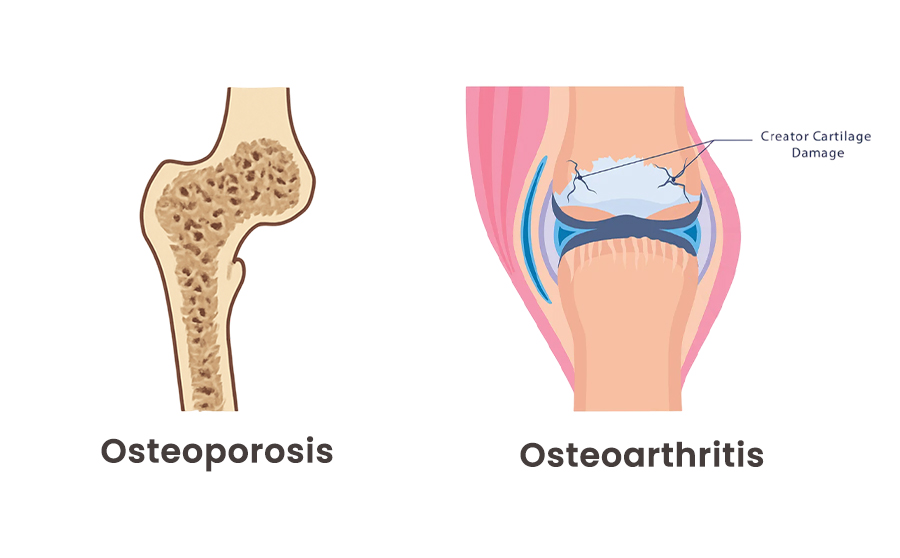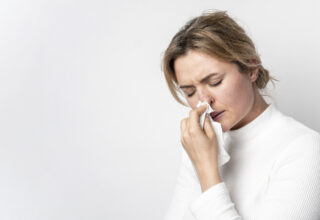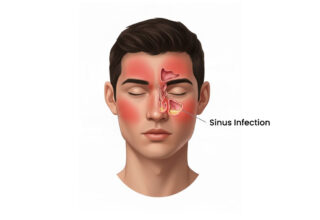When it comes to bones and joint health, two terms often come up and are frequently confused: osteoporosis and osteoarthritis. While they both sound somewhat similar and both tend to affect people as they grow old, these two conditions are quite different from each other in terms of causes, symptoms, and treatment.
Let’s learn the difference between osteoporosis and osteoarthritis, including their causes, symptoms, and management, so you can have a better understanding of each condition.

What is Osteoporosis?
Osteoporosis is a condition that affects bones and makes them weak, brittle, and more likely to break. It causes a decrease in bone density and makes it porous— hence the name “osteo” (bone) “porosis” (porous).
Common Causes of Osteoporosis:
Common causes and risk factors for osteoporosis are:
- Aging (especially in women after menopause)
- Hormonal changes (like decreased estrogen levels)
- Low calcium and vitamin D levels
- Sedentary lifestyle
- Certain medications (like steroids)
- Smoking or excessive alcohol use
- Family history of fragility fracture
Symptoms of Osteoporosis:
Osteoporosis is often called a “silent disease” because it doesn’t usually cause any noticeable symptoms until a fracture occurs. However, some signs may include:
- Bone fractures (especially in the hip, spine, or wrist) from minor falls
- Loss of height over time
- A stooped posture
- Chronic back pain due to vertebral fractures (Read about home remedies for chronic back pain)
Management of Osteoporosis:
Management of osteoporosis involves treating and preventing fractures, and using medicines to strengthen bones.
Treating osteoporosis is pretty simple but requires commitment. It typically involves three main steps:
- Getting enough calcium and vitamin D. The first step is making sure that your body has enough calcium and vitamin D to support your bone health. It can be done by improving your diet or taking supplements of calcium and vitamin D, if required
- Engaging in weight bearing exercise (like walking or strength training) that puts healthy stress on your bones and make them stronger
- Taking medications when necessary. If you’ve already been diagnosed with osteoporosis, your doctor might prescribe medications like bisphosphonates to help strengthen your bones and reduce the risk of future fractures
Skipping any of these steps can limit your progress. Consistent effort is the key to improving bone density.
What is Osteoarthritis?
Osteoarthritis (OA) is a joint disorder. It happens when the protective cartilage that cushions the ends of your bones wears down over time. This causes bones to rub against each other causing pain, swelling, and stiffness.
Common Causes of Osteoarthritis:
The exact cause of osteoarthritis isn’t fully understood, but there are many factors that are known to increase your risk of developing it.
These include:
- Previous joint injury. Repeated use of a joint that hasn’t properly healed after an injury or surgery can increase “wear and tear”
- Other health conditions that damage the joint like rheumatoid arthritis or gout
- Age— the risk increases as you get older
- Family history — although no single gene has been pinpointed as the cause
- Obesity — excess weight puts added pressure on weight bearing joints like hips and knees
- Gender — women tend to be more affected by osteoarthritis than men
Symptoms of Osteoarthritis:
Osteoarthritis tends to develop slowly and worsen with time. Its symptoms may come and go in episodes which can be related to your activity levels and even weather. However, in severe cases, symptoms can be persistent.
Key symptoms include:
- Pain and stiffness in your joints which increases especially when you haven’t moved your joint in a while
- Joint tenderness
- Swelling around the joint or joint appearing slightly larger than usual
- Loss of flexibility or range of motion
- A grating or crackling sound or sensation when moving the affected joint
Management of Osteoarthritis:
While currently there’s no cure for osteoarthritis, the condition doesn’t always get worse over time. Many people are able to manage their symptoms with the right approach.
Common treatments for osteoarthritis focus on relieving discomfort and improving quality of life. These include:
- Lifestyle changes like maintaining a healthy weight and staying active can make a big difference ( Learn more about living with joint pain )
- Medications like pain relievers and anti-inflammatory drugs can help reduce discomfort
- Supportive therapies can make your everyday life easier
In some cases, when these options don’t provide enough relief, surgery may be recommended to repair, strengthen, or even replace a damaged joint.
Key Differences Between Osteoporosis and Osteoarthritis:
| Features | Osteoporosis | Osteoarthritis |
| Affected area | Bones | Joints (cartilage and surrounding bones) |
| Primary problem | Loss of bone density | Cartilage breakdown |
| Main symptoms | Fracture (often silent until then) | Joint pain, stiffness, and swelling |
| Visible changes | Stooped posture, height loss | Joint deformity, limited mobility |
| Who’s at risk? | Postmenopausal women, older adults | Older adults, overweight people, those with joint injuries |
| Can it be cured? | No, but progression can be slowed | No, but symptoms can be managed |
Can You Have Both Conditions?
Yes, it’s possible to have both osteoporosis and osteoarthritis, at the same time, especially in the older adults. While they affect different parts of the body, their combined effects can cause more serious mobility issues, discomfort, and risk of injury.
That’s why regular checkups, a healthy diet, staying active, and keeping an eye on your bone and joint health becomes more important as you age.
Final Thoughts:
While osteoporosis and osteoarthritis may sound similar, they’re very different conditions. Understanding their difference is the first step towards their effective management.
If you’re having symptoms like joint pain, stiffness, or changes in posture, don’t ignore them. Talk to your doctor about your risk factors and what you can do to protect your bone and joint health as you age.








